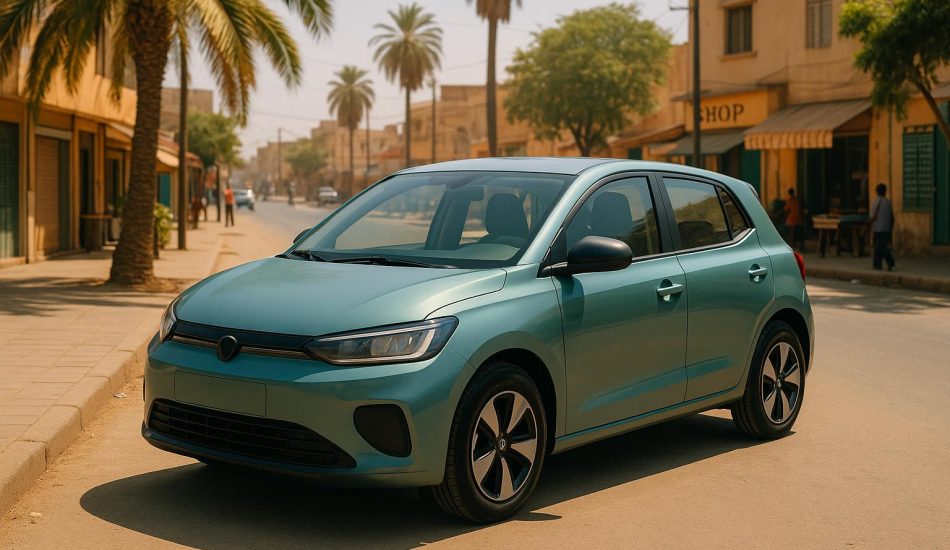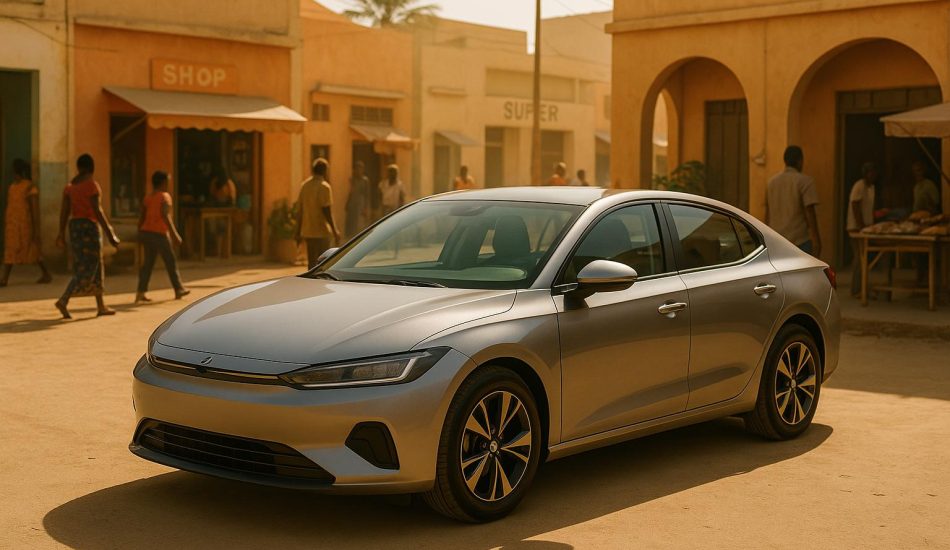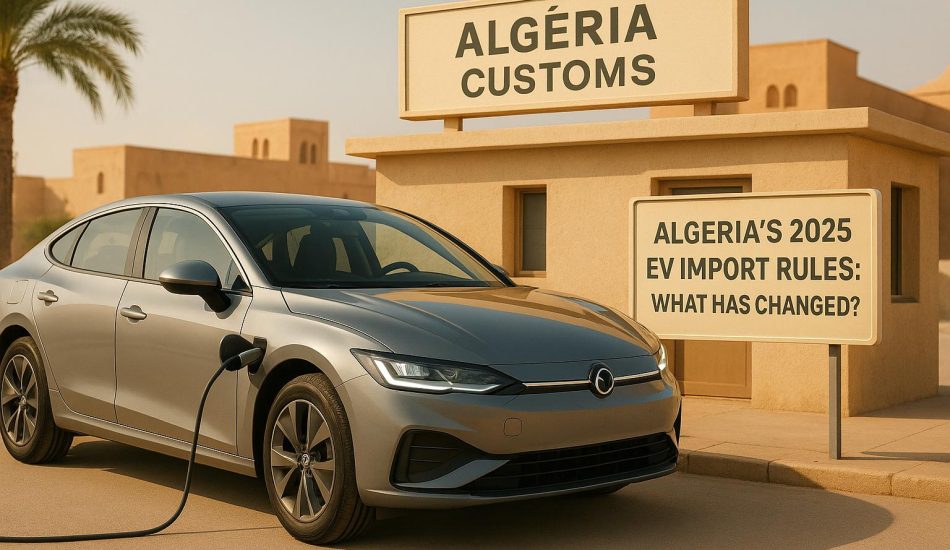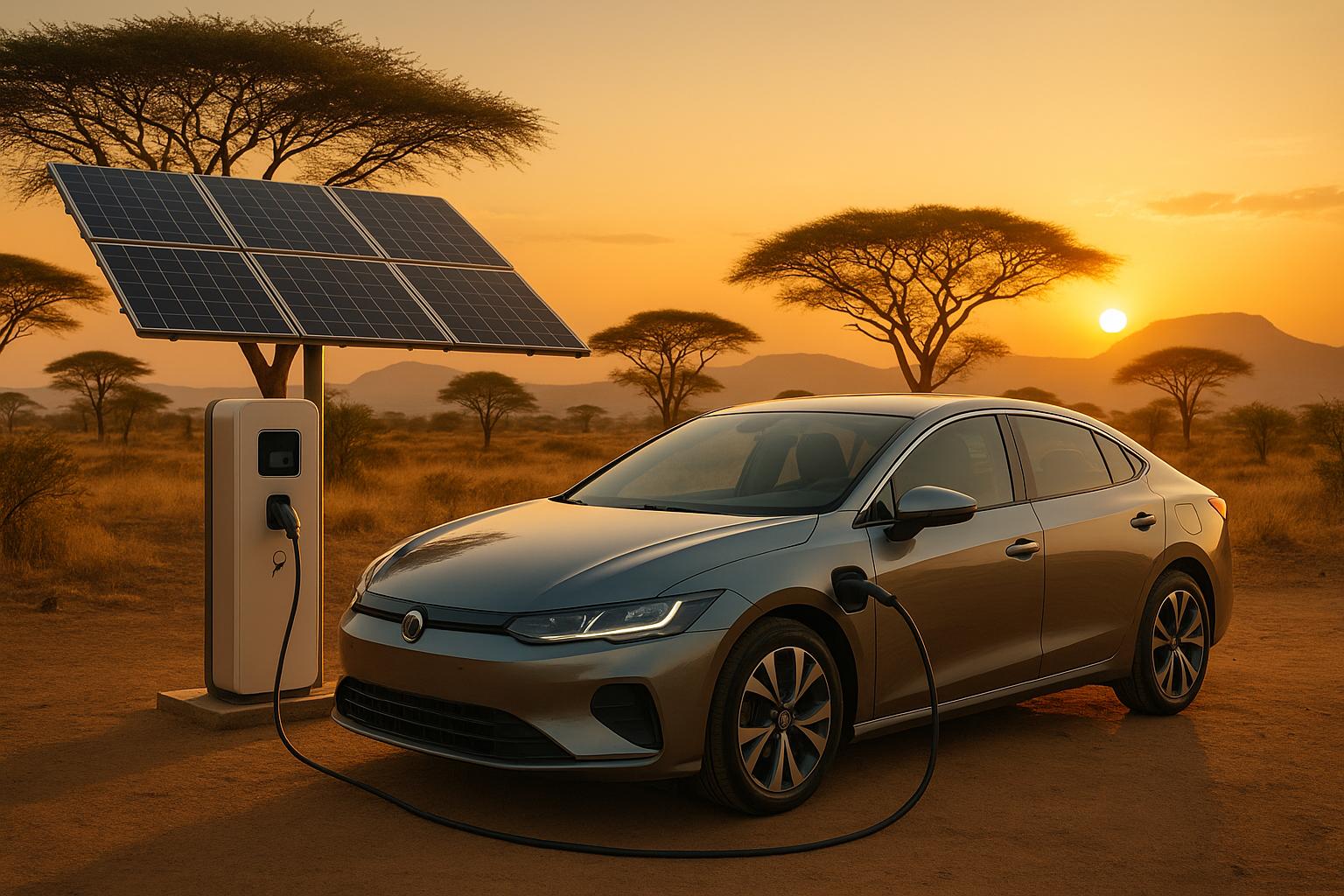
Electric vehicles (EVs) are reshaping transportation in Africa, offering cost savings and reduced emissions. With rising fuel prices and limited access to traditional energy sources, EVs are becoming a practical choice for many. Here’s a quick breakdown of the four main types of EVs and their relevance to Africa:
- BEVs (Battery Electric Vehicles): Fully electric, zero emissions, ideal for cities with charging infrastructure. Examples: Nissan Leaf, BMW i3.
- PHEVs (Plug-in Hybrid Electric Vehicles): Combine electric motors and gasoline engines for flexibility in areas with inconsistent charging networks.
- HEVs (Hybrid Electric Vehicles): Use both electric and gasoline power but don’t require charging. Great for regions with limited electricity access.
- REEVs (Range-Extended Electric Vehicles): Primarily electric but include a small generator for extended range, suitable for long-distance travel.
Challenges: Limited charging infrastructure, inconsistent government policies, and high upfront costs remain barriers. However, solutions like local manufacturing, renewable energy integration, and tailored financing options are addressing these issues.
Key Takeaways:
- BEVs suit urban areas with charging access.
- PHEVs and REEVs offer flexibility for mixed-use and rural driving.
- HEVs are practical where charging is unavailable.
EVs are not just vehicles – they’re part of a broader effort to improve energy access, reduce pollution, and create jobs across Africa. While challenges persist, the push for cleaner transportation is gaining momentum, with countries like South Africa, Kenya, and Morocco leading the way.
The Reality of Driving an Electric Vehicle in Nigeria: Prices, Batteries, chargers | EV World Africa
Features and Benefits of Each EV Type
Choosing the right type of electric vehicle (EV) depends on your driving needs and the environment you operate in. Each category of EV comes with its own strengths, making them well-suited for different situations. Here’s a closer look at the key features and benefits of each type, particularly for Africa’s unique conditions.
Battery Electric Vehicles (BEVs)
BEVs rely entirely on electricity, making them emission-free and cost-effective to operate. With fewer moving parts compared to traditional gasoline vehicles, they require less maintenance – no oil changes or spark plug replacements. These vehicles are ideal for urban settings, where distances are shorter, and charging infrastructure is more accessible.
That said, the extreme heat common in many African regions can affect battery performance. However, modern BEVs are equipped with thermal management systems to help mitigate these effects.
One standout feature of BEVs is their instant torque, which provides quick, smooth acceleration. This makes them particularly well-suited for stop-and-go traffic, such as in city centers. For businesses like taxi services or delivery operations, BEVs are a smart choice for navigating congested urban areas.
Plug-in Hybrid Electric Vehicles (PHEVs)
PHEVs combine an electric motor with a gasoline engine, offering flexibility for both short commutes and longer trips. Drivers can rely on electric power for daily urban travel, switching to the gasoline engine for journeys beyond the electric range. This dual-power system is especially useful in regions with inconsistent charging infrastructure.
Most PHEVs offer a limited electric-only range, which is sufficient for typical city driving. For longer trips between cities or across rural areas, the gasoline engine provides peace of mind by ensuring uninterrupted travel.
By primarily using electricity for shorter trips, PHEVs can significantly reduce fuel costs, while the backup gasoline engine offers the versatility needed for extended drives. This combination makes them a practical option for a wide range of driving scenarios.
Hybrid Electric Vehicles (HEVs)
HEVs use both an electric motor and a gasoline engine, but they don’t require external charging. Instead, they recharge through regenerative braking and engine power. The result? Better fuel efficiency without the need for a charging station.
HEVs are a great choice for areas with limited access to reliable electricity or charging infrastructure. They automatically switch between electric and gasoline power to optimize fuel consumption, delivering better mileage than conventional cars.
Another advantage is reduced maintenance – since the electric motor shares the workload, the gasoline engine experiences less wear and tear. HEVs are perfect for drivers who need fuel-efficient, low-maintenance vehicles for both short and long trips.
Range-Extended Electric Vehicles (REEVs)
REEVs are primarily electric vehicles but include a small gasoline engine that acts as a generator to recharge the battery when needed. While the electric motor powers the vehicle, the gasoline engine ensures a longer range by producing electricity on demand.
This setup offers the quiet, smooth driving experience of a BEV while addressing concerns about running out of battery power during longer trips. The gasoline generator provides an extra layer of reliability for extended travel.
REEVs shine in situations where charging infrastructure is sparse. They deliver the environmental and operational perks of electric driving for daily use, while the gasoline generator ensures you can cover long distances without worrying about recharging. This balance makes them a versatile choice for a mix of urban and rural driving needs.
Challenges for EV Adoption in Africa
Electric vehicles (EVs) hold great promise, but their adoption in Africa is hindered by challenges tied to infrastructure, government policies, and costs.
Infrastructure and Energy Issues
One of the biggest hurdles is the lack of charging infrastructure. In many areas, public charging stations are scarce, making reliable access to charging facilities uncertain. On top of that, unstable power grids in some regions complicate the situation, creating concerns about whether charging will be consistently available.
Although Africa has immense potential for renewable energy – thanks to abundant sunlight and strong wind resources – building a dependable and widespread charging network requires significant investment. This includes not only installing charging stations but also improving power transmission and distribution systems to handle the increased demand.
Government Policies and Support
Policies and regulations play a pivotal role in shaping EV adoption, but the landscape across Africa is uneven. Some countries have introduced tax breaks and other incentives to encourage EV use, while others impose higher tariffs or lack clear regulatory frameworks. This inconsistency can deter both consumers and investors.
For EVs to thrive, governments need to establish clear standards covering safety, charging protocols, and integration with existing power grids. Such measures would reduce market uncertainty, attract investment, and help create a more reliable ecosystem for EVs.
Cost and Financing Options
Affordability is another major roadblock. EVs are often more expensive than traditional gasoline-powered cars, and banks tend to view them as higher-risk investments, leading to less favorable loan terms. Import dependency further inflates costs – shipping fees, tariffs, and supply chain delays all add up. Without local manufacturing, spare parts and components are not only pricier but also harder to source.
To tackle these financial barriers, innovative solutions are emerging. Pay-as-you-go models allow buyers to make smaller, manageable payments over time, while leasing programs – especially for businesses – offer predictable monthly costs without requiring a large down payment. Additionally, partnerships between EV companies and local financial institutions are helping to create tailored credit solutions, such as credit guarantees and reimbursable grants, to make EVs more accessible and support the transition to cleaner transportation options in Africa.
sbb-itb-99e19e3
Comparing BEVs, PHEVs, HEVs, and REEVs
This section simplifies the key differences between the four main types of electric vehicles to help you decide which one fits your lifestyle, budget, and the infrastructure available in your area. In Africa, where driving conditions and access to charging stations can vary widely, understanding these distinctions is crucial.
Battery Electric Vehicles (BEVs) are ideal for drivers with consistent daily routes and access to reliable charging points. They produce no direct emissions and have low running costs but require careful planning for charging. Plug-in Hybrid Electric Vehicles (PHEVs) offer a mix of electric-only driving for short trips and fuel-powered range for longer journeys, making them versatile. Hybrid Electric Vehicles (HEVs) are perfect for areas with inconsistent electricity supply, as they don’t require external charging and focus on fuel efficiency. Range-Extended Electric Vehicles (REEVs), though less common in Africa, primarily use electricity for driving but include a generator for longer trips.
Urban drivers often find BEVs and HEVs more suitable, while those who frequently travel between cities might prefer the extended range offered by PHEVs or REEVs.
Comparison Table: Features and Best Uses
Here’s a quick-reference table summarizing the key features and ideal use cases for each type of electric vehicle:
| Feature | BEV | PHEV | HEV | REEV |
|---|---|---|---|---|
| Driving Range | Fully electric; range varies by model | Short electric range with extended fuel range | Extended range via efficient fuel use | Mostly electric, with a generator for longer trips |
| Charging Method | Requires plug-in charging | Plug-in charging plus regenerative braking | Relies on regenerative braking and refueling | Plug-in charging with an onboard generator |
| Fuel Consumption | Fully electric | Combines electric and fuel modes | More efficient than traditional vehicles | Mainly electric, with fuel as backup |
| Purchase Price | Higher upfront cost | Balanced cost for electric and fuel systems | Lower initial cost | Higher due to complex systems |
| Maintenance Needs | Minimal due to fewer moving parts | Maintenance for both electric and engine systems | Moderate, focused on engine upkeep | Moderate, reflecting dual powertrains |
| Emissions | Zero direct emissions | Low emissions, depending on usage | Lower than conventional vehicles | Minimal emissions during electric operation |
| Best For | Daily commutes with charging access | Drivers needing both electric and extended range | Areas with limited charging infrastructure | Predominantly electric driving with occasional long trips |
| Infrastructure Requirements | Requires a strong charging network | Benefits from charging access but can run on fuel | Operates with traditional refueling | Needs charging access, supplemented by fuel availability |
BEVs may cost more upfront but save money in the long run with lower maintenance and operating expenses. PHEVs strike a balance between electric benefits and fuel flexibility, while HEVs offer a lower-cost entry point with fuel savings. REEVs, on the other hand, deliver extended electric driving but come with higher complexity and price tags.
In Africa, these differences are particularly relevant. For example, BEVs are becoming more practical in cities like Cape Town, Casablanca, and Accra, where charging networks are gradually expanding. However, in rural areas or for long-distance travel, the flexibility of PHEVs and REEVs is often more advantageous. HEVs remain a popular option in regions where charging infrastructure is still limited.
Climate also plays a role. In extreme heat (above 95°F or 35°C), BEV battery efficiency can drop, reducing range. PHEVs and REEVs can switch to engine power when battery performance dips, while HEVs are less impacted since they rely more on fuel.
For many African drivers, the decision comes down to balancing environmental priorities with practical realities. BEVs provide a clean, electric-focused experience but demand a robust charging network. PHEVs offer a practical middle ground between electric and fuel power. HEVs improve fuel efficiency without requiring charging, and REEVs combine electric driving with extended range capabilities, though at a higher cost.
Electric Vehicle Models Available in Africa
The electric vehicle (EV) market in Africa is growing steadily, with manufacturers now offering a range of Battery Electric Vehicles (BEVs), Hybrid Electric Vehicles (HEVs), and Plug-in Hybrid Electric Vehicles (PHEVs) that cater to the region’s unique needs. As of 2025, the focus is on affordability and practicality, making EVs more accessible to a wider audience. Below are some of the top models reshaping transportation across Africa.
Top EV Models in Africa
International brands are introducing BEVs equipped with advanced features, while affordability remains a key factor driving EV adoption. African consumers are increasingly looking for vehicles that deliver value and a quicker return on investment. Recognizing this demand, Chinese automakers are making significant inroads into the African market by offering cost-effective EVs tailored to local conditions.
In sub-Saharan Africa, electric two-wheelers are particularly popular in urban areas such as Ethiopia, Kenya, Nigeria, Rwanda, and Uganda. Their low lifetime costs and minimal charging requirements make them an ideal choice for city mobility. At the same time, local manufacturing initiatives in countries like Kenya, Nigeria, Rwanda, and South Africa are gaining momentum. These locally manufactured EVs focus on reliability and easy maintenance, addressing specific challenges such as road conditions and limited charging infrastructure.
Why Choose EV24.africa for Your EV Purchase
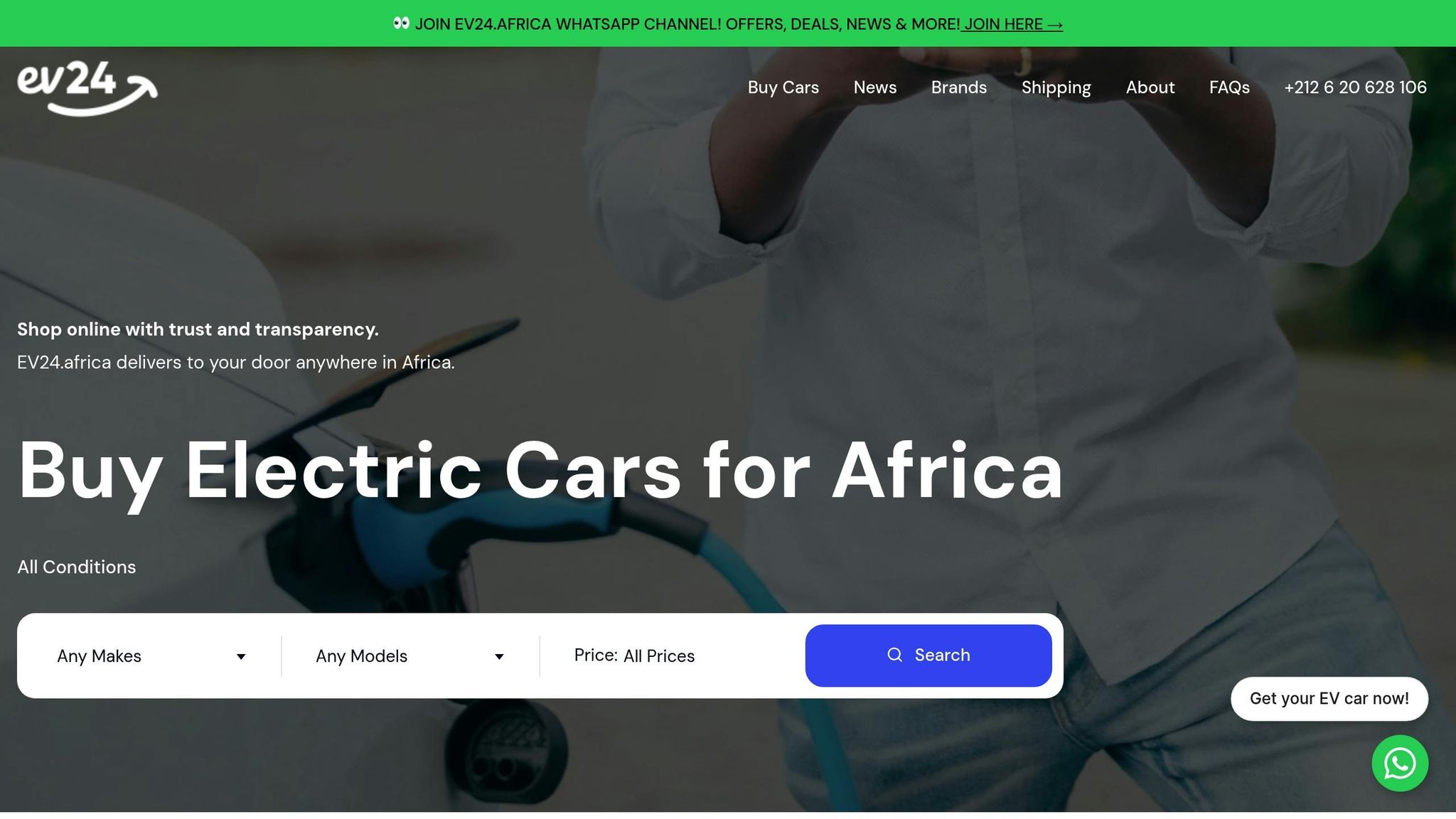
EV24.africa stands out as a leading platform for buying electric vehicles in Africa, offering a wide selection of both new and used models. The platform is designed to address the distinct challenges faced by African buyers, such as limited charging networks and budget constraints. With brands like Tesla, BYD, and Hyundai available, EV24.africa ensures a variety of options across different price points.
Transparent Pricing
One of EV24.africa’s key advantages is its commitment to clear and upfront pricing. Each vehicle listing includes detailed specifications, actual photos, and pricing without hidden fees. This level of transparency is especially important in African markets, where prices can vary significantly by region and dealership.
Tailored Financing Options
To make EVs more affordable, EV24.africa partners with local financial institutions to offer financing solutions that accommodate diverse income levels and credit systems. These tailored options help bridge the financial gap for many buyers.
Delivery Across Africa
EV24.africa provides delivery services to all 54 African countries, breaking down geographical barriers. Whether you’re in bustling Cape Town or a rural village in Uganda, the platform handles shipping logistics, import duties, and documentation requirements – making EV ownership hassle-free.
Expert Vehicle Inspections
Every vehicle listed on the platform undergoes a thorough inspection, covering critical aspects like battery health, charging systems, and overall condition. This is particularly valuable for used EVs, where battery performance is a key concern.
Local Market Expertise
EV24.africa’s team brings in-depth knowledge of regional differences, including electricity costs, charging infrastructure, and local regulations. This expertise helps buyers make informed decisions that align with their specific needs and circumstances.
Extensive Dealer Network
The platform collaborates with a network of international manufacturers and local importers, ensuring competitive prices and reliable support. This network is essential for maintenance and warranty services, especially in regions where manufacturer presence is limited.
Customer Reviews and Ratings
Real-world insights from African EV owners provide valuable information about how different models perform under local conditions. These reviews cover everything from handling extreme temperatures to navigating varied road surfaces.
Comparison Tools for Informed Decisions
For those transitioning from traditional vehicles, EV24.africa offers comparison tools to evaluate the total cost of ownership. These tools factor in electricity costs, maintenance savings, and available government incentives, helping buyers understand the long-term benefits of going electric.
With its comprehensive approach, EV24.africa is helping to make electric vehicles a practical and appealing choice for drivers across Africa.
The Future of Electric Cars in Africa
After exploring the current types of electric vehicles (EVs) and the challenges they face, let’s look ahead to how Africa’s EV market could evolve by 2025 and beyond. A mix of government policies, advancements in technology, and changing consumer preferences is expected to drive significant transformation. These factors are poised to redefine transportation across the continent.
What to Expect in 2025 and Beyond
The next few years are set to bring notable progress. Many African countries are already working to expand and improve EV charging networks. National initiatives aimed at increasing charging accessibility are gaining momentum, while technological breakthroughs are driving down battery costs, making EVs more affordable. Additionally, the rise of local manufacturing will lead to vehicles tailored specifically for Africa’s unique road conditions and transportation needs. Policies supporting EV adoption and infrastructure development will likely speed up this transition, with public services and commercial fleets leading the way toward electric mobility.
Building Better Transportation in Africa
These technical advancements and policy changes won’t just impact the automotive market – they’ll also influence broader transportation systems and economic growth. Electric vehicles promise more than reduced emissions; they hold the potential to spur economic development. The shift to electric mobility could create jobs in manufacturing, maintenance, and energy sectors, while decreasing dependency on imported fossil fuels. In regions where renewable energy is integrated, EV adoption could also enhance energy independence.
The simpler mechanics of EVs mean lower maintenance costs, a crucial advantage for both individual owners and businesses facing challenges with traditional vehicles. Urban planners in several African cities are already redesigning public transit systems, incorporating electric buses and ride-sharing services into their plans. On top of that, expanding charging infrastructure could bring reliable electricity access to rural areas, opening doors to improved healthcare, education, and other economic opportunities.
These developments paint a hopeful picture of transportation in Africa – one that’s cleaner, more accessible, and economically beneficial for all.
FAQs
What are the differences between BEVs, PHEVs, HEVs, and REEVs, and which one is best for Africa?
The key difference between BEVs, PHEVs, HEVs, and REEVs lies in how they are powered and recharged.
- BEVs (Battery Electric Vehicles): These run solely on electricity and need to be charged using external power sources. They’re an excellent choice for cities with a well-developed charging network.
- PHEVs (Plug-in Hybrid Electric Vehicles): Equipped with both a battery and a gasoline engine, these vehicles can operate on electricity for short trips and switch to fuel for longer journeys. This makes them versatile for both city and rural driving.
- HEVs (Hybrid Electric Vehicles): These combine a gasoline engine with an electric motor but don’t require external charging. They’re a practical option for areas where charging infrastructure is limited.
- REEVs (Range-Extended Electric Vehicles): A subtype of PHEVs, these have larger batteries and offer a longer electric range. They’re particularly suited for long-distance travel in regions with few charging stations.
Choosing the right type of EV for Africa depends on factors like the availability of charging stations, your driving habits, and the terrain. BEVs are ideal for urban areas, while PHEVs and REEVs work well for mixed-use scenarios. HEVs, on the other hand, are a reliable choice for regions with minimal or no charging facilities.
What is being done to improve charging infrastructure for electric vehicles in Africa?
Efforts to boost charging infrastructure in Africa are tapping into solar-powered off-grid charging stations, a smart solution for areas where electricity supply can be unpredictable. By utilizing renewable energy, these stations are addressing the challenge of limited grid access in many regions.
At the same time, both governments and private companies are stepping up to expand public charging networks. The focus is on urban hubs and major transit routes, where demand is highest. Collaborations with renewable energy providers and large-scale projects are also paving the way for hybrid and off-grid charging systems, making charging more accessible to a wider audience.
These developments are playing an important role in supporting the rise of electric vehicles across Africa, helping to make EVs a more practical choice for everyday consumers.
What financial options are available to make electric vehicles more affordable in Africa?
In Africa, various financial initiatives are working to make electric vehicles (EVs) more accessible to consumers. Some governments are stepping in with tax breaks, reduced import duties, and subsidies to bring down the initial purchase price of EVs. These efforts aim to ease the financial burden and encourage more people to make the switch.
Flexible payment options, like leasing programs, are also gaining traction. For example, certain plans let consumers lease an EV for as little as $25 a day. This approach spreads out the cost, making EV ownership a realistic option for a broader audience.
By combining these strategies, individuals and businesses are finding it easier to embrace electric mobility, fueling the growth of the EV market across the continent.


